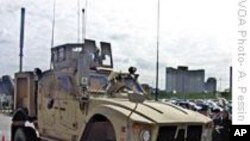The U.S. military has begun deploying a new generation of relatively light-weight all-terrain armored vehicles to Afghanistan, which have enough armor to protect troops from deadly roadside bombs but are not too heavy for the country's relatively undeveloped road network.
This report is about the latest effort to reduce the record and rising casualty levels among U.S. troops in Afghanistan, as President Barack Obama considers sending tens of thousands more troops into harm's way. But it comes with a consumer advisory label: Warning, the following story unavoidably contains military acronyms and technical terminology.
The story really begins in Iraq several years ago, when insurgents first began using home-made roadside bombs against the High-Mobility Multipurpose Wheeled Vehicle, or Humvee, the main vehicle the troops were using.
"MRAPs are lifesavers," says Assistant Secretary of Defense Ashton Carter.
But, he explains, the MRAPs did not work so well in Afghanistan.
"The terrain in Afghanistan is different from Iraq, it's more uneven, the roads are less easy to traverse. And for that reason, we've had to create an all-terrain version of the MRAP," he said.
The challenge for designers was to create a vehicle with the protection provided by an MRAP but about 25 per cent lighter. And so, an acronym within an acronym was born - the M-ATV, or MRAP All-Terrain Vehicle.
"This vehicle here will similarly be a lifesaver in Afghanistan," he added.
And the U.S. military needs a 'lifesaver' in Afghanistan. American casualties have jumped from fewer than 40 per month until June of this year, to 70 or more every month since then. Officials say like in Iraq, the main killers are roadside bombs.
Standing outside the Pentagon Monday in front of one of the hulking desert sand colored new vehicles designed to protect against those bombs, Assistant Secretary Carter extolled the M-ATV's virtues.
"It has a lot more survivability than other vehicles that are in Afghanistan right now, a great deal more. Believe it or not, it's very easy to drive. So it's a wonderful vehicle and it's going to be a lifesaver," he said.
Although smaller than the MRAP, the M-ATV is still an imposing vehicle, half-again as tall as the average person and weighing in at 18 metric tons.
They look like an extra-large version of the World War Two jeep, but enclosed, with small blast-proof windows, a protected machine gun position on top and a variety of high-tech gear inside and out. The U.S. military is buying more than 6,000 of the M-ATVs, at a cost of nearly a million and a half dollars each, including all their equipment, spare parts and transportation to Afghanistan. U.S. officials say other countries with troops in Afghanistan want to buy some of the vehicles, too.
The MRAP and M-ATV project director, Marine Corps Brigadier General Michael Brogan, says the new vehicles will protect troops on Afghanistan's roads, without destroying the roads or getting stuck on them. He says it will also enable the troops to be less predictable in their movements, and get away from areas where the bombs are planted.
"This is really designed to get us off the road network, to be able to go cross-country, to go the places that up-armored HUMVEEs go, not be stuck to the road network, which makes us predictable," he said.
General Brogan says because of some technical innovations M-ATVs are not nearly as cumbersome as MRAPs, but rather are almost as maneuverable as the much lighter and more lightly armored Humvees, even in the sands of Afghanistan.
"The tires are larger than you would find on a HUMVEE, so the ground pressure, which is really what matters, isn't all that much different from an up-armored HUMVEE," said Brogan. "The fact that this four-wheel independent suspension, the amount of horsepower in the engine, the tractive effort that's delivered to the drive train allows the vehicle to go off road in soil and terrain characteristics similar to what an up-armored HUMVEE can carry. So this is a very capable platform," he added.
For security reasons, officials will not say how large a bomb the M-ATVs can withstand. But they expect the arrival of hundreds, and eventually thousands, of the vehicles in Afghanistan will help reverse the trend of U.S. casualties, and will enable the troops to travel safely throughout the country.






